HR7003: Sustainable Business Success via Resource Management
VerifiedAdded on 2023/06/18
|11
|3519
|429
Report
AI Summary
This report examines the critical aspects of managing human and financial resources for sustainable business success, particularly in the context of the COVID-19 pandemic. It delves into various leadership approaches, theories, and their impact on organizational change. The report discusses the relationship between flexible leadership and change management, highlighting the importance of adapting to evolving business environments. It also explores theoretical models of leadership and different leadership styles, emphasizing their significance in successfully managing change. Methodologies for data collection, including situational analysis and documentary interpretation, are outlined. The report concludes with recommendations for executives on effectively managing organizations during challenging times. Desklib offers a wealth of similar resources for students seeking solved assignments and past papers.

Managing human and
financial resources for
sustainable business
success
financial resources for
sustainable business
success
Paraphrase This Document
Need a fresh take? Get an instant paraphrase of this document with our AI Paraphraser
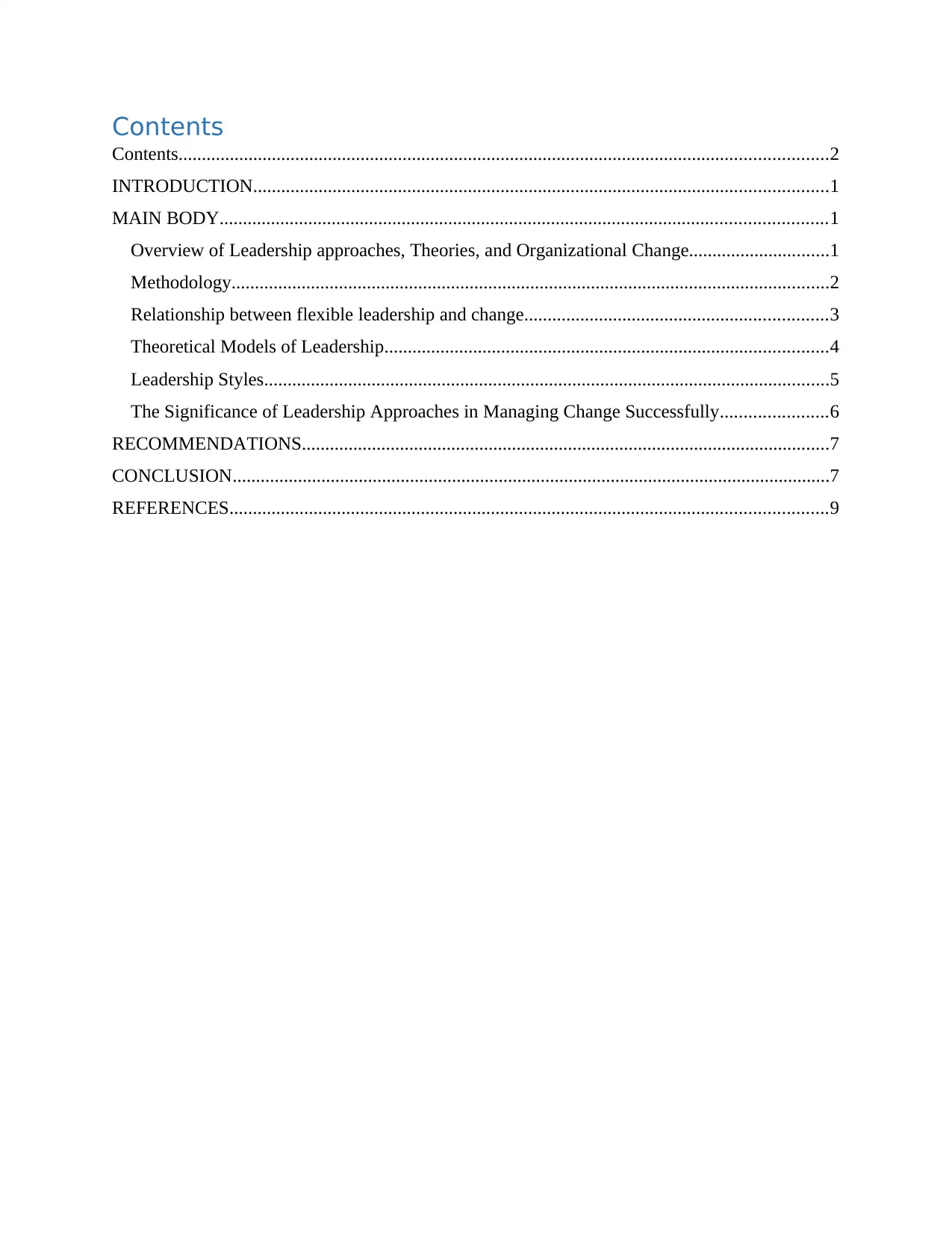
Contents
Contents...........................................................................................................................................2
INTRODUCTION...........................................................................................................................1
MAIN BODY..................................................................................................................................1
Overview of Leadership approaches, Theories, and Organizational Change..............................1
Methodology................................................................................................................................2
Relationship between flexible leadership and change.................................................................3
Theoretical Models of Leadership...............................................................................................4
Leadership Styles.........................................................................................................................5
The Significance of Leadership Approaches in Managing Change Successfully.......................6
RECOMMENDATIONS.................................................................................................................7
CONCLUSION................................................................................................................................7
REFERENCES................................................................................................................................9
Contents...........................................................................................................................................2
INTRODUCTION...........................................................................................................................1
MAIN BODY..................................................................................................................................1
Overview of Leadership approaches, Theories, and Organizational Change..............................1
Methodology................................................................................................................................2
Relationship between flexible leadership and change.................................................................3
Theoretical Models of Leadership...............................................................................................4
Leadership Styles.........................................................................................................................5
The Significance of Leadership Approaches in Managing Change Successfully.......................6
RECOMMENDATIONS.................................................................................................................7
CONCLUSION................................................................................................................................7
REFERENCES................................................................................................................................9
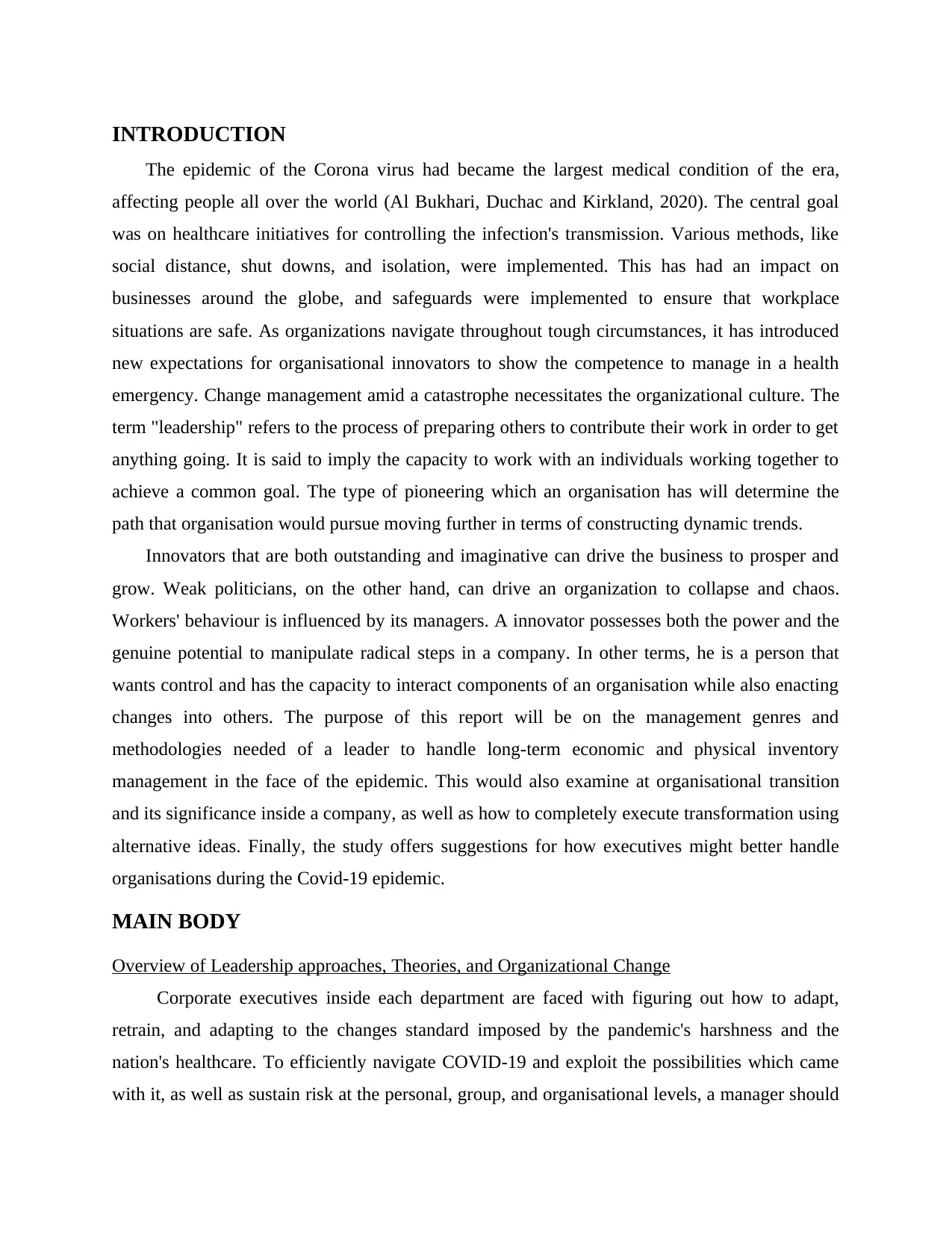
INTRODUCTION
The epidemic of the Corona virus had became the largest medical condition of the era,
affecting people all over the world (Al Bukhari, Duchac and Kirkland, 2020). The central goal
was on healthcare initiatives for controlling the infection's transmission. Various methods, like
social distance, shut downs, and isolation, were implemented. This has had an impact on
businesses around the globe, and safeguards were implemented to ensure that workplace
situations are safe. As organizations navigate throughout tough circumstances, it has introduced
new expectations for organisational innovators to show the competence to manage in a health
emergency. Change management amid a catastrophe necessitates the organizational culture. The
term "leadership" refers to the process of preparing others to contribute their work in order to get
anything going. It is said to imply the capacity to work with an individuals working together to
achieve a common goal. The type of pioneering which an organisation has will determine the
path that organisation would pursue moving further in terms of constructing dynamic trends.
Innovators that are both outstanding and imaginative can drive the business to prosper and
grow. Weak politicians, on the other hand, can drive an organization to collapse and chaos.
Workers' behaviour is influenced by its managers. A innovator possesses both the power and the
genuine potential to manipulate radical steps in a company. In other terms, he is a person that
wants control and has the capacity to interact components of an organisation while also enacting
changes into others. The purpose of this report will be on the management genres and
methodologies needed of a leader to handle long-term economic and physical inventory
management in the face of the epidemic. This would also examine at organisational transition
and its significance inside a company, as well as how to completely execute transformation using
alternative ideas. Finally, the study offers suggestions for how executives might better handle
organisations during the Covid-19 epidemic.
MAIN BODY
Overview of Leadership approaches, Theories, and Organizational Change
Corporate executives inside each department are faced with figuring out how to adapt,
retrain, and adapting to the changes standard imposed by the pandemic's harshness and the
nation's healthcare. To efficiently navigate COVID-19 and exploit the possibilities which came
with it, as well as sustain risk at the personal, group, and organisational levels, a manager should
The epidemic of the Corona virus had became the largest medical condition of the era,
affecting people all over the world (Al Bukhari, Duchac and Kirkland, 2020). The central goal
was on healthcare initiatives for controlling the infection's transmission. Various methods, like
social distance, shut downs, and isolation, were implemented. This has had an impact on
businesses around the globe, and safeguards were implemented to ensure that workplace
situations are safe. As organizations navigate throughout tough circumstances, it has introduced
new expectations for organisational innovators to show the competence to manage in a health
emergency. Change management amid a catastrophe necessitates the organizational culture. The
term "leadership" refers to the process of preparing others to contribute their work in order to get
anything going. It is said to imply the capacity to work with an individuals working together to
achieve a common goal. The type of pioneering which an organisation has will determine the
path that organisation would pursue moving further in terms of constructing dynamic trends.
Innovators that are both outstanding and imaginative can drive the business to prosper and
grow. Weak politicians, on the other hand, can drive an organization to collapse and chaos.
Workers' behaviour is influenced by its managers. A innovator possesses both the power and the
genuine potential to manipulate radical steps in a company. In other terms, he is a person that
wants control and has the capacity to interact components of an organisation while also enacting
changes into others. The purpose of this report will be on the management genres and
methodologies needed of a leader to handle long-term economic and physical inventory
management in the face of the epidemic. This would also examine at organisational transition
and its significance inside a company, as well as how to completely execute transformation using
alternative ideas. Finally, the study offers suggestions for how executives might better handle
organisations during the Covid-19 epidemic.
MAIN BODY
Overview of Leadership approaches, Theories, and Organizational Change
Corporate executives inside each department are faced with figuring out how to adapt,
retrain, and adapting to the changes standard imposed by the pandemic's harshness and the
nation's healthcare. To efficiently navigate COVID-19 and exploit the possibilities which came
with it, as well as sustain risk at the personal, group, and organisational levels, a manager should
⊘ This is a preview!⊘
Do you want full access?
Subscribe today to unlock all pages.

Trusted by 1+ million students worldwide
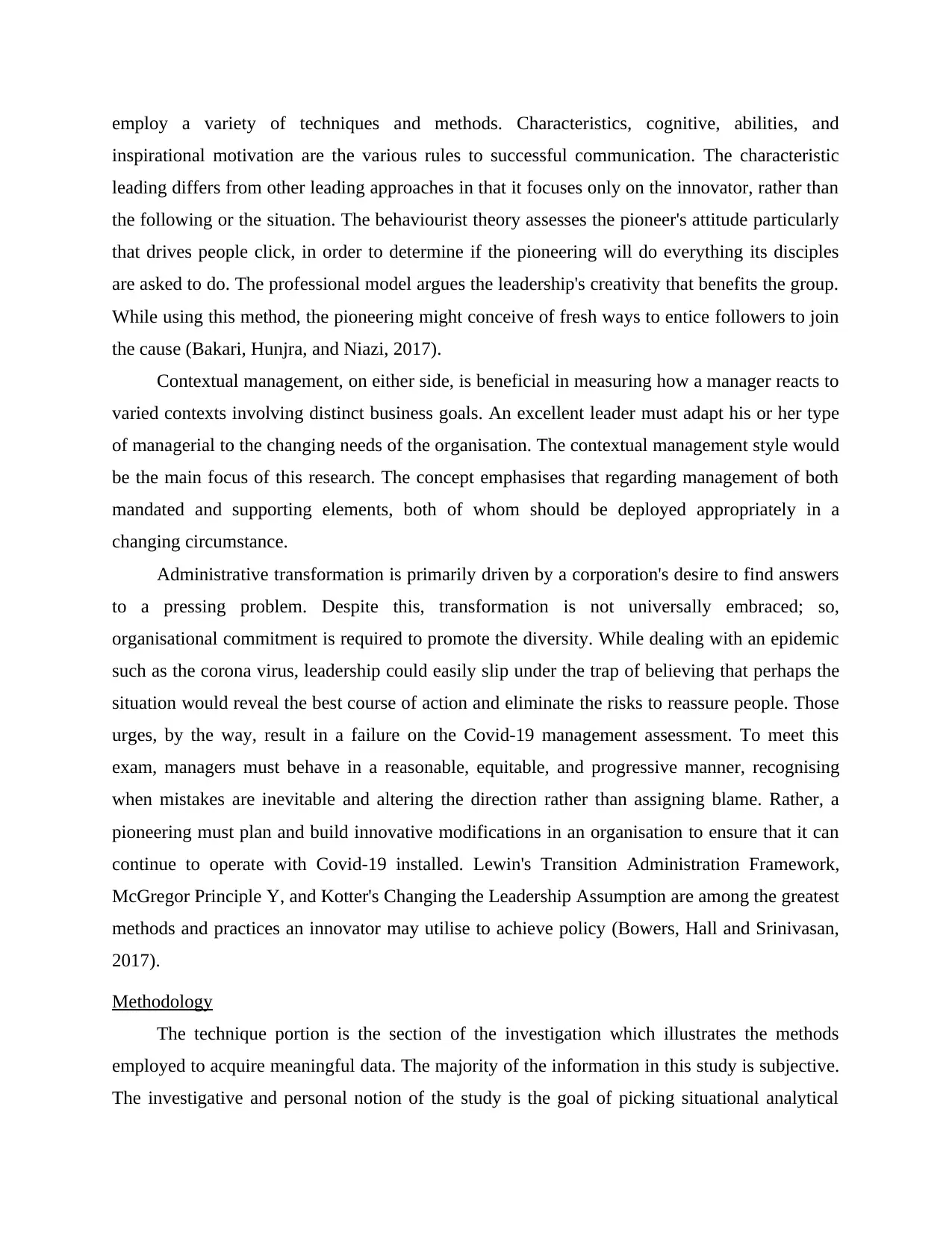
employ a variety of techniques and methods. Characteristics, cognitive, abilities, and
inspirational motivation are the various rules to successful communication. The characteristic
leading differs from other leading approaches in that it focuses only on the innovator, rather than
the following or the situation. The behaviourist theory assesses the pioneer's attitude particularly
that drives people click, in order to determine if the pioneering will do everything its disciples
are asked to do. The professional model argues the leadership's creativity that benefits the group.
While using this method, the pioneering might conceive of fresh ways to entice followers to join
the cause (Bakari, Hunjra, and Niazi, 2017).
Contextual management, on either side, is beneficial in measuring how a manager reacts to
varied contexts involving distinct business goals. An excellent leader must adapt his or her type
of managerial to the changing needs of the organisation. The contextual management style would
be the main focus of this research. The concept emphasises that regarding management of both
mandated and supporting elements, both of whom should be deployed appropriately in a
changing circumstance.
Administrative transformation is primarily driven by a corporation's desire to find answers
to a pressing problem. Despite this, transformation is not universally embraced; so,
organisational commitment is required to promote the diversity. While dealing with an epidemic
such as the corona virus, leadership could easily slip under the trap of believing that perhaps the
situation would reveal the best course of action and eliminate the risks to reassure people. Those
urges, by the way, result in a failure on the Covid-19 management assessment. To meet this
exam, managers must behave in a reasonable, equitable, and progressive manner, recognising
when mistakes are inevitable and altering the direction rather than assigning blame. Rather, a
pioneering must plan and build innovative modifications in an organisation to ensure that it can
continue to operate with Covid-19 installed. Lewin's Transition Administration Framework,
McGregor Principle Y, and Kotter's Changing the Leadership Assumption are among the greatest
methods and practices an innovator may utilise to achieve policy (Bowers, Hall and Srinivasan,
2017).
Methodology
The technique portion is the section of the investigation which illustrates the methods
employed to acquire meaningful data. The majority of the information in this study is subjective.
The investigative and personal notion of the study is the goal of picking situational analytical
inspirational motivation are the various rules to successful communication. The characteristic
leading differs from other leading approaches in that it focuses only on the innovator, rather than
the following or the situation. The behaviourist theory assesses the pioneer's attitude particularly
that drives people click, in order to determine if the pioneering will do everything its disciples
are asked to do. The professional model argues the leadership's creativity that benefits the group.
While using this method, the pioneering might conceive of fresh ways to entice followers to join
the cause (Bakari, Hunjra, and Niazi, 2017).
Contextual management, on either side, is beneficial in measuring how a manager reacts to
varied contexts involving distinct business goals. An excellent leader must adapt his or her type
of managerial to the changing needs of the organisation. The contextual management style would
be the main focus of this research. The concept emphasises that regarding management of both
mandated and supporting elements, both of whom should be deployed appropriately in a
changing circumstance.
Administrative transformation is primarily driven by a corporation's desire to find answers
to a pressing problem. Despite this, transformation is not universally embraced; so,
organisational commitment is required to promote the diversity. While dealing with an epidemic
such as the corona virus, leadership could easily slip under the trap of believing that perhaps the
situation would reveal the best course of action and eliminate the risks to reassure people. Those
urges, by the way, result in a failure on the Covid-19 management assessment. To meet this
exam, managers must behave in a reasonable, equitable, and progressive manner, recognising
when mistakes are inevitable and altering the direction rather than assigning blame. Rather, a
pioneering must plan and build innovative modifications in an organisation to ensure that it can
continue to operate with Covid-19 installed. Lewin's Transition Administration Framework,
McGregor Principle Y, and Kotter's Changing the Leadership Assumption are among the greatest
methods and practices an innovator may utilise to achieve policy (Bowers, Hall and Srinivasan,
2017).
Methodology
The technique portion is the section of the investigation which illustrates the methods
employed to acquire meaningful data. The majority of the information in this study is subjective.
The investigative and personal notion of the study is the goal of picking situational analytical
Paraphrase This Document
Need a fresh take? Get an instant paraphrase of this document with our AI Paraphraser
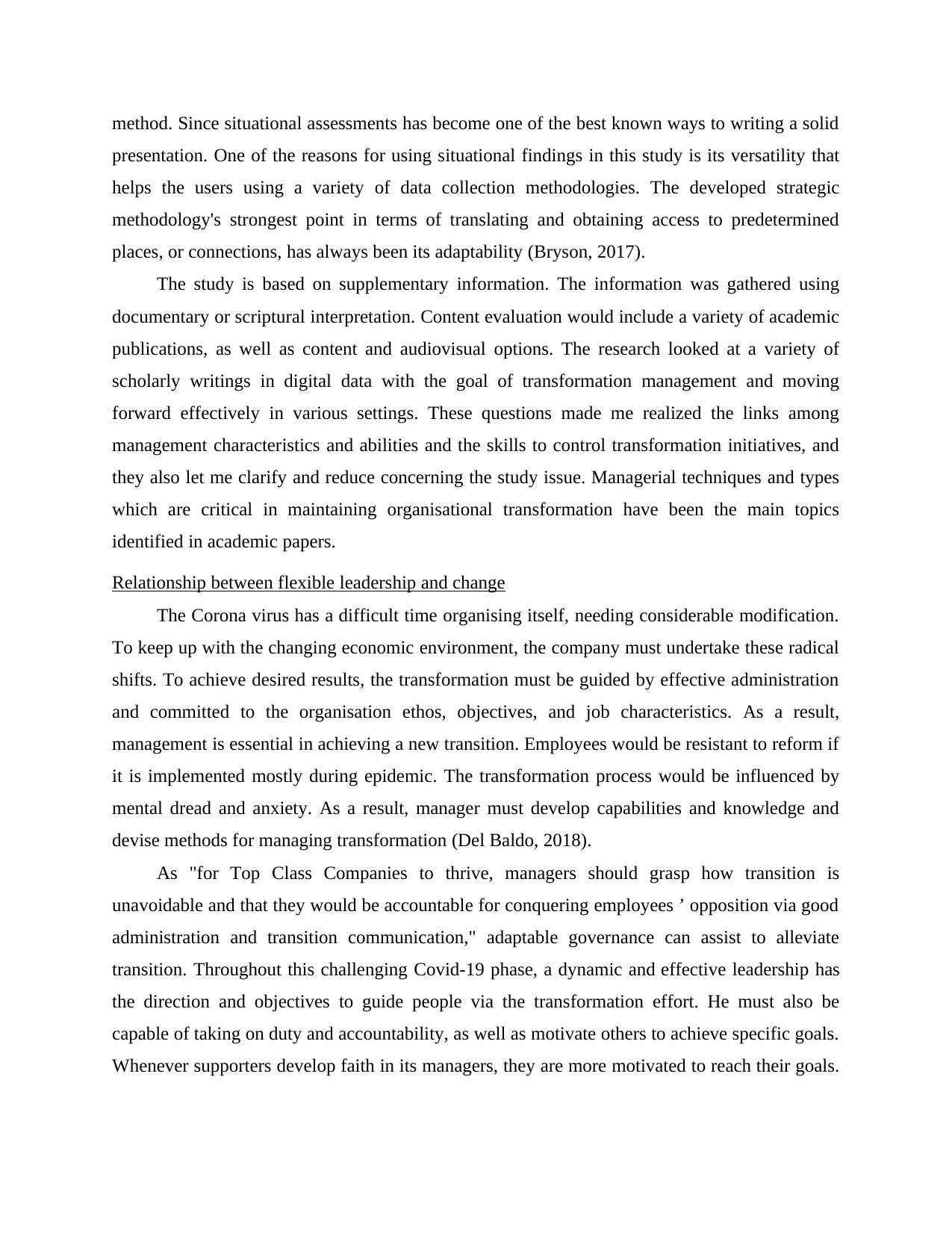
method. Since situational assessments has become one of the best known ways to writing a solid
presentation. One of the reasons for using situational findings in this study is its versatility that
helps the users using a variety of data collection methodologies. The developed strategic
methodology's strongest point in terms of translating and obtaining access to predetermined
places, or connections, has always been its adaptability (Bryson, 2017).
The study is based on supplementary information. The information was gathered using
documentary or scriptural interpretation. Content evaluation would include a variety of academic
publications, as well as content and audiovisual options. The research looked at a variety of
scholarly writings in digital data with the goal of transformation management and moving
forward effectively in various settings. These questions made me realized the links among
management characteristics and abilities and the skills to control transformation initiatives, and
they also let me clarify and reduce concerning the study issue. Managerial techniques and types
which are critical in maintaining organisational transformation have been the main topics
identified in academic papers.
Relationship between flexible leadership and change
The Corona virus has a difficult time organising itself, needing considerable modification.
To keep up with the changing economic environment, the company must undertake these radical
shifts. To achieve desired results, the transformation must be guided by effective administration
and committed to the organisation ethos, objectives, and job characteristics. As a result,
management is essential in achieving a new transition. Employees would be resistant to reform if
it is implemented mostly during epidemic. The transformation process would be influenced by
mental dread and anxiety. As a result, manager must develop capabilities and knowledge and
devise methods for managing transformation (Del Baldo, 2018).
As "for Top Class Companies to thrive, managers should grasp how transition is
unavoidable and that they would be accountable for conquering employees ’ opposition via good
administration and transition communication," adaptable governance can assist to alleviate
transition. Throughout this challenging Covid-19 phase, a dynamic and effective leadership has
the direction and objectives to guide people via the transformation effort. He must also be
capable of taking on duty and accountability, as well as motivate others to achieve specific goals.
Whenever supporters develop faith in its managers, they are more motivated to reach their goals.
presentation. One of the reasons for using situational findings in this study is its versatility that
helps the users using a variety of data collection methodologies. The developed strategic
methodology's strongest point in terms of translating and obtaining access to predetermined
places, or connections, has always been its adaptability (Bryson, 2017).
The study is based on supplementary information. The information was gathered using
documentary or scriptural interpretation. Content evaluation would include a variety of academic
publications, as well as content and audiovisual options. The research looked at a variety of
scholarly writings in digital data with the goal of transformation management and moving
forward effectively in various settings. These questions made me realized the links among
management characteristics and abilities and the skills to control transformation initiatives, and
they also let me clarify and reduce concerning the study issue. Managerial techniques and types
which are critical in maintaining organisational transformation have been the main topics
identified in academic papers.
Relationship between flexible leadership and change
The Corona virus has a difficult time organising itself, needing considerable modification.
To keep up with the changing economic environment, the company must undertake these radical
shifts. To achieve desired results, the transformation must be guided by effective administration
and committed to the organisation ethos, objectives, and job characteristics. As a result,
management is essential in achieving a new transition. Employees would be resistant to reform if
it is implemented mostly during epidemic. The transformation process would be influenced by
mental dread and anxiety. As a result, manager must develop capabilities and knowledge and
devise methods for managing transformation (Del Baldo, 2018).
As "for Top Class Companies to thrive, managers should grasp how transition is
unavoidable and that they would be accountable for conquering employees ’ opposition via good
administration and transition communication," adaptable governance can assist to alleviate
transition. Throughout this challenging Covid-19 phase, a dynamic and effective leadership has
the direction and objectives to guide people via the transformation effort. He must also be
capable of taking on duty and accountability, as well as motivate others to achieve specific goals.
Whenever supporters develop faith in its managers, they are more motivated to reach their goals.
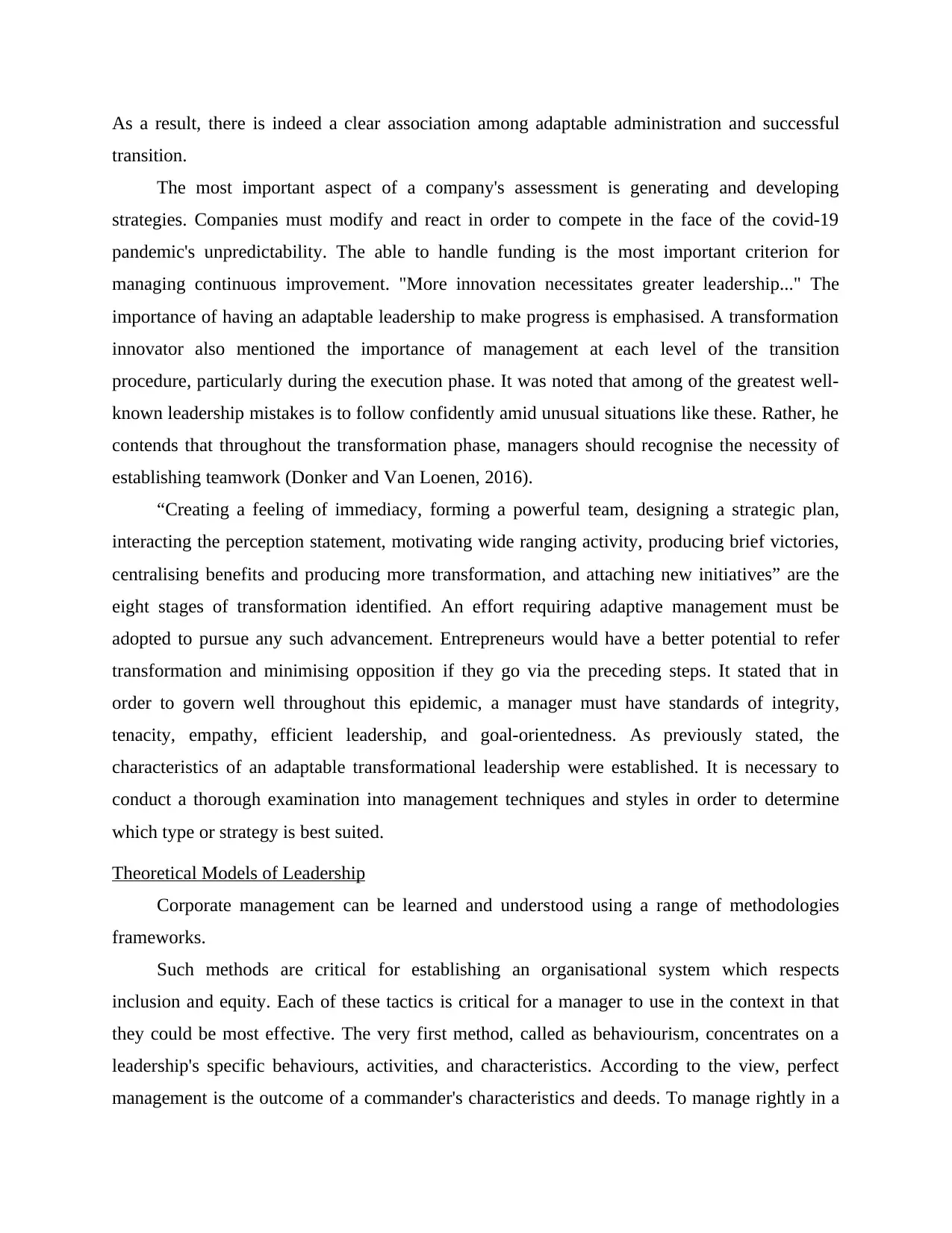
As a result, there is indeed a clear association among adaptable administration and successful
transition.
The most important aspect of a company's assessment is generating and developing
strategies. Companies must modify and react in order to compete in the face of the covid-19
pandemic's unpredictability. The able to handle funding is the most important criterion for
managing continuous improvement. "More innovation necessitates greater leadership..." The
importance of having an adaptable leadership to make progress is emphasised. A transformation
innovator also mentioned the importance of management at each level of the transition
procedure, particularly during the execution phase. It was noted that among of the greatest well-
known leadership mistakes is to follow confidently amid unusual situations like these. Rather, he
contends that throughout the transformation phase, managers should recognise the necessity of
establishing teamwork (Donker and Van Loenen, 2016).
“Creating a feeling of immediacy, forming a powerful team, designing a strategic plan,
interacting the perception statement, motivating wide ranging activity, producing brief victories,
centralising benefits and producing more transformation, and attaching new initiatives” are the
eight stages of transformation identified. An effort requiring adaptive management must be
adopted to pursue any such advancement. Entrepreneurs would have a better potential to refer
transformation and minimising opposition if they go via the preceding steps. It stated that in
order to govern well throughout this epidemic, a manager must have standards of integrity,
tenacity, empathy, efficient leadership, and goal-orientedness. As previously stated, the
characteristics of an adaptable transformational leadership were established. It is necessary to
conduct a thorough examination into management techniques and styles in order to determine
which type or strategy is best suited.
Theoretical Models of Leadership
Corporate management can be learned and understood using a range of methodologies
frameworks.
Such methods are critical for establishing an organisational system which respects
inclusion and equity. Each of these tactics is critical for a manager to use in the context in that
they could be most effective. The very first method, called as behaviourism, concentrates on a
leadership's specific behaviours, activities, and characteristics. According to the view, perfect
management is the outcome of a commander's characteristics and deeds. To manage rightly in a
transition.
The most important aspect of a company's assessment is generating and developing
strategies. Companies must modify and react in order to compete in the face of the covid-19
pandemic's unpredictability. The able to handle funding is the most important criterion for
managing continuous improvement. "More innovation necessitates greater leadership..." The
importance of having an adaptable leadership to make progress is emphasised. A transformation
innovator also mentioned the importance of management at each level of the transition
procedure, particularly during the execution phase. It was noted that among of the greatest well-
known leadership mistakes is to follow confidently amid unusual situations like these. Rather, he
contends that throughout the transformation phase, managers should recognise the necessity of
establishing teamwork (Donker and Van Loenen, 2016).
“Creating a feeling of immediacy, forming a powerful team, designing a strategic plan,
interacting the perception statement, motivating wide ranging activity, producing brief victories,
centralising benefits and producing more transformation, and attaching new initiatives” are the
eight stages of transformation identified. An effort requiring adaptive management must be
adopted to pursue any such advancement. Entrepreneurs would have a better potential to refer
transformation and minimising opposition if they go via the preceding steps. It stated that in
order to govern well throughout this epidemic, a manager must have standards of integrity,
tenacity, empathy, efficient leadership, and goal-orientedness. As previously stated, the
characteristics of an adaptable transformational leadership were established. It is necessary to
conduct a thorough examination into management techniques and styles in order to determine
which type or strategy is best suited.
Theoretical Models of Leadership
Corporate management can be learned and understood using a range of methodologies
frameworks.
Such methods are critical for establishing an organisational system which respects
inclusion and equity. Each of these tactics is critical for a manager to use in the context in that
they could be most effective. The very first method, called as behaviourism, concentrates on a
leadership's specific behaviours, activities, and characteristics. According to the view, perfect
management is the outcome of a commander's characteristics and deeds. To manage rightly in a
⊘ This is a preview!⊘
Do you want full access?
Subscribe today to unlock all pages.

Trusted by 1+ million students worldwide
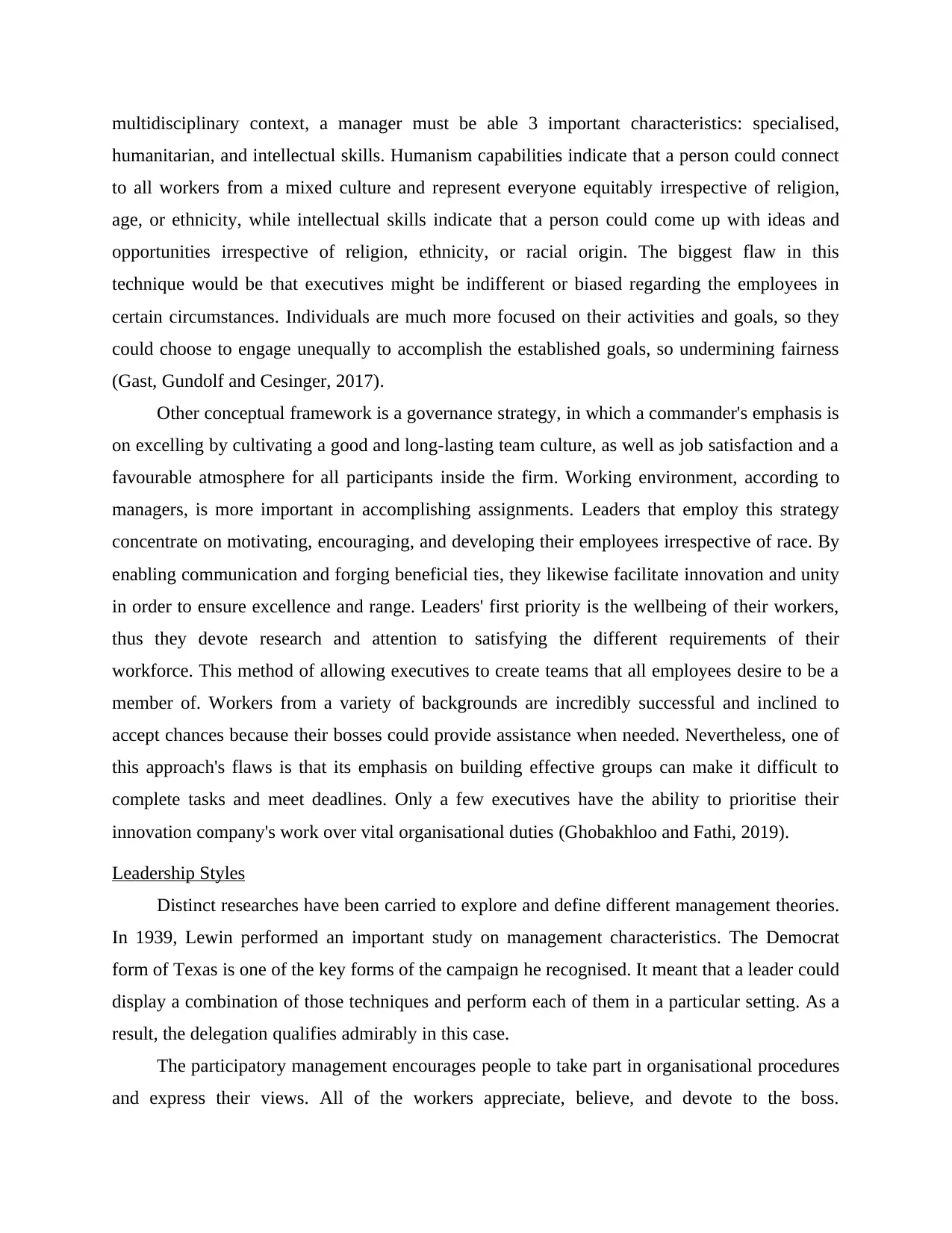
multidisciplinary context, a manager must be able 3 important characteristics: specialised,
humanitarian, and intellectual skills. Humanism capabilities indicate that a person could connect
to all workers from a mixed culture and represent everyone equitably irrespective of religion,
age, or ethnicity, while intellectual skills indicate that a person could come up with ideas and
opportunities irrespective of religion, ethnicity, or racial origin. The biggest flaw in this
technique would be that executives might be indifferent or biased regarding the employees in
certain circumstances. Individuals are much more focused on their activities and goals, so they
could choose to engage unequally to accomplish the established goals, so undermining fairness
(Gast, Gundolf and Cesinger, 2017).
Other conceptual framework is a governance strategy, in which a commander's emphasis is
on excelling by cultivating a good and long-lasting team culture, as well as job satisfaction and a
favourable atmosphere for all participants inside the firm. Working environment, according to
managers, is more important in accomplishing assignments. Leaders that employ this strategy
concentrate on motivating, encouraging, and developing their employees irrespective of race. By
enabling communication and forging beneficial ties, they likewise facilitate innovation and unity
in order to ensure excellence and range. Leaders' first priority is the wellbeing of their workers,
thus they devote research and attention to satisfying the different requirements of their
workforce. This method of allowing executives to create teams that all employees desire to be a
member of. Workers from a variety of backgrounds are incredibly successful and inclined to
accept chances because their bosses could provide assistance when needed. Nevertheless, one of
this approach's flaws is that its emphasis on building effective groups can make it difficult to
complete tasks and meet deadlines. Only a few executives have the ability to prioritise their
innovation company's work over vital organisational duties (Ghobakhloo and Fathi, 2019).
Leadership Styles
Distinct researches have been carried to explore and define different management theories.
In 1939, Lewin performed an important study on management characteristics. The Democrat
form of Texas is one of the key forms of the campaign he recognised. It meant that a leader could
display a combination of those techniques and perform each of them in a particular setting. As a
result, the delegation qualifies admirably in this case.
The participatory management encourages people to take part in organisational procedures
and express their views. All of the workers appreciate, believe, and devote to the boss.
humanitarian, and intellectual skills. Humanism capabilities indicate that a person could connect
to all workers from a mixed culture and represent everyone equitably irrespective of religion,
age, or ethnicity, while intellectual skills indicate that a person could come up with ideas and
opportunities irrespective of religion, ethnicity, or racial origin. The biggest flaw in this
technique would be that executives might be indifferent or biased regarding the employees in
certain circumstances. Individuals are much more focused on their activities and goals, so they
could choose to engage unequally to accomplish the established goals, so undermining fairness
(Gast, Gundolf and Cesinger, 2017).
Other conceptual framework is a governance strategy, in which a commander's emphasis is
on excelling by cultivating a good and long-lasting team culture, as well as job satisfaction and a
favourable atmosphere for all participants inside the firm. Working environment, according to
managers, is more important in accomplishing assignments. Leaders that employ this strategy
concentrate on motivating, encouraging, and developing their employees irrespective of race. By
enabling communication and forging beneficial ties, they likewise facilitate innovation and unity
in order to ensure excellence and range. Leaders' first priority is the wellbeing of their workers,
thus they devote research and attention to satisfying the different requirements of their
workforce. This method of allowing executives to create teams that all employees desire to be a
member of. Workers from a variety of backgrounds are incredibly successful and inclined to
accept chances because their bosses could provide assistance when needed. Nevertheless, one of
this approach's flaws is that its emphasis on building effective groups can make it difficult to
complete tasks and meet deadlines. Only a few executives have the ability to prioritise their
innovation company's work over vital organisational duties (Ghobakhloo and Fathi, 2019).
Leadership Styles
Distinct researches have been carried to explore and define different management theories.
In 1939, Lewin performed an important study on management characteristics. The Democrat
form of Texas is one of the key forms of the campaign he recognised. It meant that a leader could
display a combination of those techniques and perform each of them in a particular setting. As a
result, the delegation qualifies admirably in this case.
The participatory management encourages people to take part in organisational procedures
and express their views. All of the workers appreciate, believe, and devote to the boss.
Paraphrase This Document
Need a fresh take? Get an instant paraphrase of this document with our AI Paraphraser
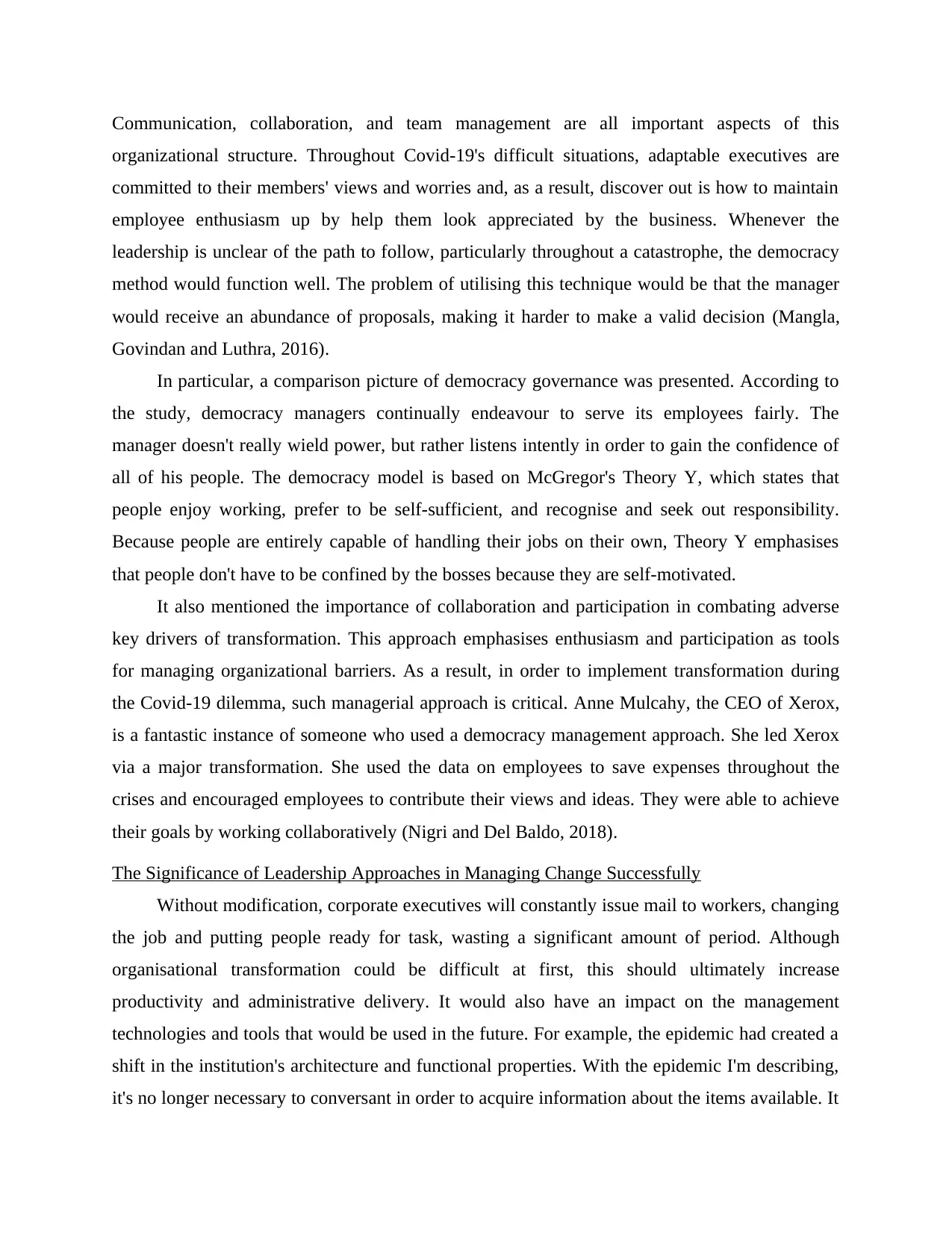
Communication, collaboration, and team management are all important aspects of this
organizational structure. Throughout Covid-19's difficult situations, adaptable executives are
committed to their members' views and worries and, as a result, discover out is how to maintain
employee enthusiasm up by help them look appreciated by the business. Whenever the
leadership is unclear of the path to follow, particularly throughout a catastrophe, the democracy
method would function well. The problem of utilising this technique would be that the manager
would receive an abundance of proposals, making it harder to make a valid decision (Mangla,
Govindan and Luthra, 2016).
In particular, a comparison picture of democracy governance was presented. According to
the study, democracy managers continually endeavour to serve its employees fairly. The
manager doesn't really wield power, but rather listens intently in order to gain the confidence of
all of his people. The democracy model is based on McGregor's Theory Y, which states that
people enjoy working, prefer to be self-sufficient, and recognise and seek out responsibility.
Because people are entirely capable of handling their jobs on their own, Theory Y emphasises
that people don't have to be confined by the bosses because they are self-motivated.
It also mentioned the importance of collaboration and participation in combating adverse
key drivers of transformation. This approach emphasises enthusiasm and participation as tools
for managing organizational barriers. As a result, in order to implement transformation during
the Covid-19 dilemma, such managerial approach is critical. Anne Mulcahy, the CEO of Xerox,
is a fantastic instance of someone who used a democracy management approach. She led Xerox
via a major transformation. She used the data on employees to save expenses throughout the
crises and encouraged employees to contribute their views and ideas. They were able to achieve
their goals by working collaboratively (Nigri and Del Baldo, 2018).
The Significance of Leadership Approaches in Managing Change Successfully
Without modification, corporate executives will constantly issue mail to workers, changing
the job and putting people ready for task, wasting a significant amount of period. Although
organisational transformation could be difficult at first, this should ultimately increase
productivity and administrative delivery. It would also have an impact on the management
technologies and tools that would be used in the future. For example, the epidemic had created a
shift in the institution's architecture and functional properties. With the epidemic I'm describing,
it's no longer necessary to conversant in order to acquire information about the items available. It
organizational structure. Throughout Covid-19's difficult situations, adaptable executives are
committed to their members' views and worries and, as a result, discover out is how to maintain
employee enthusiasm up by help them look appreciated by the business. Whenever the
leadership is unclear of the path to follow, particularly throughout a catastrophe, the democracy
method would function well. The problem of utilising this technique would be that the manager
would receive an abundance of proposals, making it harder to make a valid decision (Mangla,
Govindan and Luthra, 2016).
In particular, a comparison picture of democracy governance was presented. According to
the study, democracy managers continually endeavour to serve its employees fairly. The
manager doesn't really wield power, but rather listens intently in order to gain the confidence of
all of his people. The democracy model is based on McGregor's Theory Y, which states that
people enjoy working, prefer to be self-sufficient, and recognise and seek out responsibility.
Because people are entirely capable of handling their jobs on their own, Theory Y emphasises
that people don't have to be confined by the bosses because they are self-motivated.
It also mentioned the importance of collaboration and participation in combating adverse
key drivers of transformation. This approach emphasises enthusiasm and participation as tools
for managing organizational barriers. As a result, in order to implement transformation during
the Covid-19 dilemma, such managerial approach is critical. Anne Mulcahy, the CEO of Xerox,
is a fantastic instance of someone who used a democracy management approach. She led Xerox
via a major transformation. She used the data on employees to save expenses throughout the
crises and encouraged employees to contribute their views and ideas. They were able to achieve
their goals by working collaboratively (Nigri and Del Baldo, 2018).
The Significance of Leadership Approaches in Managing Change Successfully
Without modification, corporate executives will constantly issue mail to workers, changing
the job and putting people ready for task, wasting a significant amount of period. Although
organisational transformation could be difficult at first, this should ultimately increase
productivity and administrative delivery. It would also have an impact on the management
technologies and tools that would be used in the future. For example, the epidemic had created a
shift in the institution's architecture and functional properties. With the epidemic I'm describing,
it's no longer necessary to conversant in order to acquire information about the items available. It
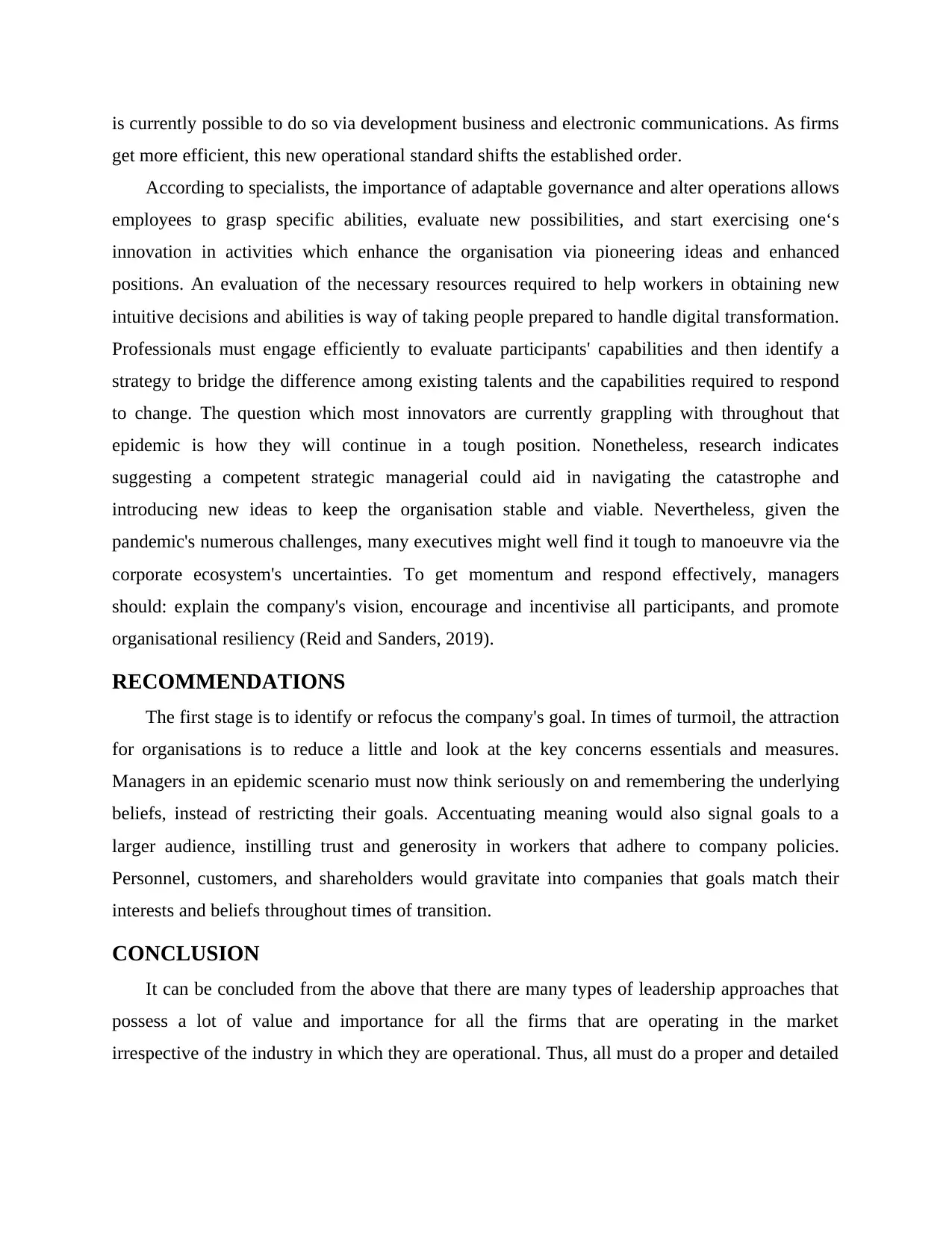
is currently possible to do so via development business and electronic communications. As firms
get more efficient, this new operational standard shifts the established order.
According to specialists, the importance of adaptable governance and alter operations allows
employees to grasp specific abilities, evaluate new possibilities, and start exercising one‘s
innovation in activities which enhance the organisation via pioneering ideas and enhanced
positions. An evaluation of the necessary resources required to help workers in obtaining new
intuitive decisions and abilities is way of taking people prepared to handle digital transformation.
Professionals must engage efficiently to evaluate participants' capabilities and then identify a
strategy to bridge the difference among existing talents and the capabilities required to respond
to change. The question which most innovators are currently grappling with throughout that
epidemic is how they will continue in a tough position. Nonetheless, research indicates
suggesting a competent strategic managerial could aid in navigating the catastrophe and
introducing new ideas to keep the organisation stable and viable. Nevertheless, given the
pandemic's numerous challenges, many executives might well find it tough to manoeuvre via the
corporate ecosystem's uncertainties. To get momentum and respond effectively, managers
should: explain the company's vision, encourage and incentivise all participants, and promote
organisational resiliency (Reid and Sanders, 2019).
RECOMMENDATIONS
The first stage is to identify or refocus the company's goal. In times of turmoil, the attraction
for organisations is to reduce a little and look at the key concerns essentials and measures.
Managers in an epidemic scenario must now think seriously on and remembering the underlying
beliefs, instead of restricting their goals. Accentuating meaning would also signal goals to a
larger audience, instilling trust and generosity in workers that adhere to company policies.
Personnel, customers, and shareholders would gravitate into companies that goals match their
interests and beliefs throughout times of transition.
CONCLUSION
It can be concluded from the above that there are many types of leadership approaches that
possess a lot of value and importance for all the firms that are operating in the market
irrespective of the industry in which they are operational. Thus, all must do a proper and detailed
get more efficient, this new operational standard shifts the established order.
According to specialists, the importance of adaptable governance and alter operations allows
employees to grasp specific abilities, evaluate new possibilities, and start exercising one‘s
innovation in activities which enhance the organisation via pioneering ideas and enhanced
positions. An evaluation of the necessary resources required to help workers in obtaining new
intuitive decisions and abilities is way of taking people prepared to handle digital transformation.
Professionals must engage efficiently to evaluate participants' capabilities and then identify a
strategy to bridge the difference among existing talents and the capabilities required to respond
to change. The question which most innovators are currently grappling with throughout that
epidemic is how they will continue in a tough position. Nonetheless, research indicates
suggesting a competent strategic managerial could aid in navigating the catastrophe and
introducing new ideas to keep the organisation stable and viable. Nevertheless, given the
pandemic's numerous challenges, many executives might well find it tough to manoeuvre via the
corporate ecosystem's uncertainties. To get momentum and respond effectively, managers
should: explain the company's vision, encourage and incentivise all participants, and promote
organisational resiliency (Reid and Sanders, 2019).
RECOMMENDATIONS
The first stage is to identify or refocus the company's goal. In times of turmoil, the attraction
for organisations is to reduce a little and look at the key concerns essentials and measures.
Managers in an epidemic scenario must now think seriously on and remembering the underlying
beliefs, instead of restricting their goals. Accentuating meaning would also signal goals to a
larger audience, instilling trust and generosity in workers that adhere to company policies.
Personnel, customers, and shareholders would gravitate into companies that goals match their
interests and beliefs throughout times of transition.
CONCLUSION
It can be concluded from the above that there are many types of leadership approaches that
possess a lot of value and importance for all the firms that are operating in the market
irrespective of the industry in which they are operational. Thus, all must do a proper and detailed
⊘ This is a preview!⊘
Do you want full access?
Subscribe today to unlock all pages.

Trusted by 1+ million students worldwide
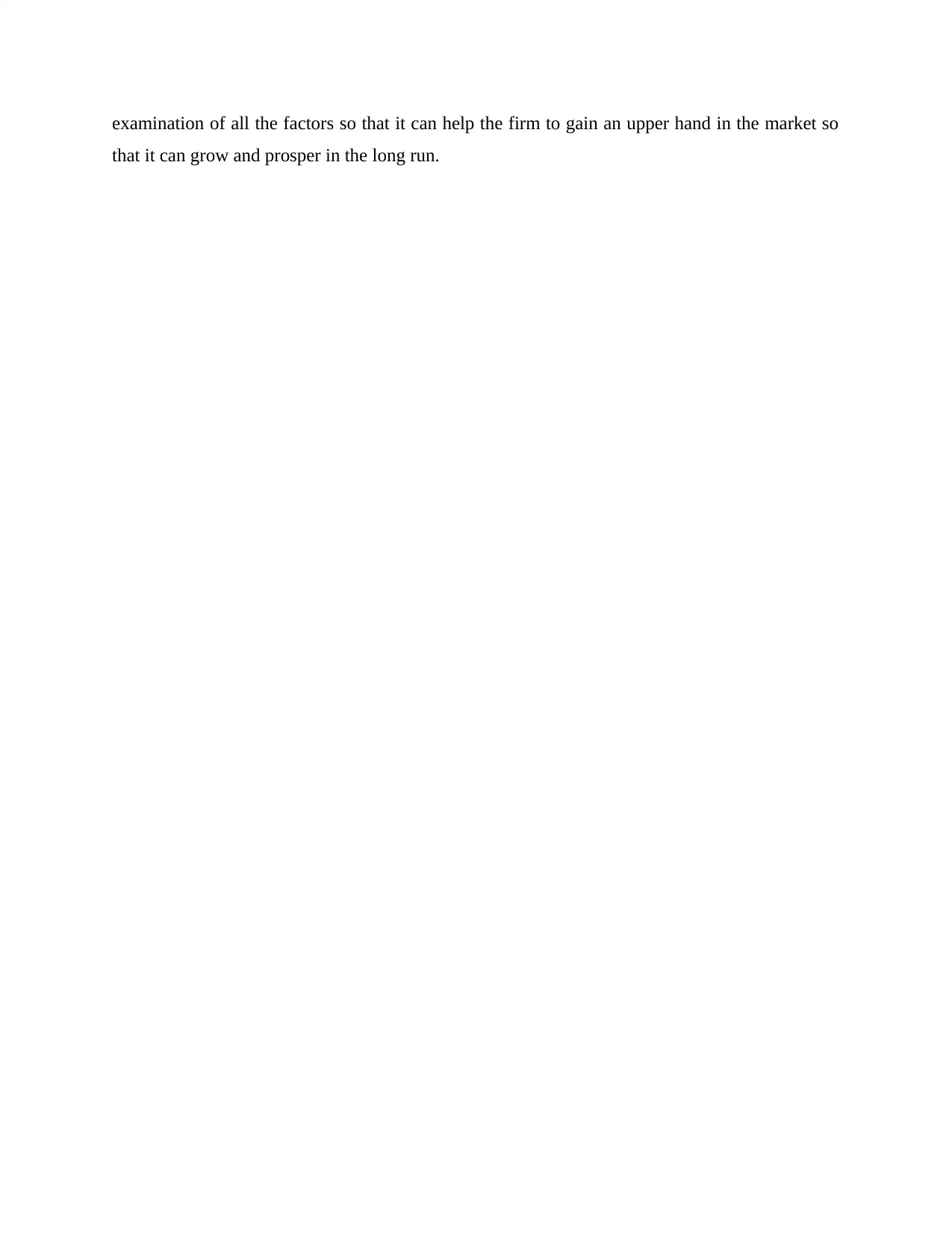
examination of all the factors so that it can help the firm to gain an upper hand in the market so
that it can grow and prosper in the long run.
that it can grow and prosper in the long run.
Paraphrase This Document
Need a fresh take? Get an instant paraphrase of this document with our AI Paraphraser
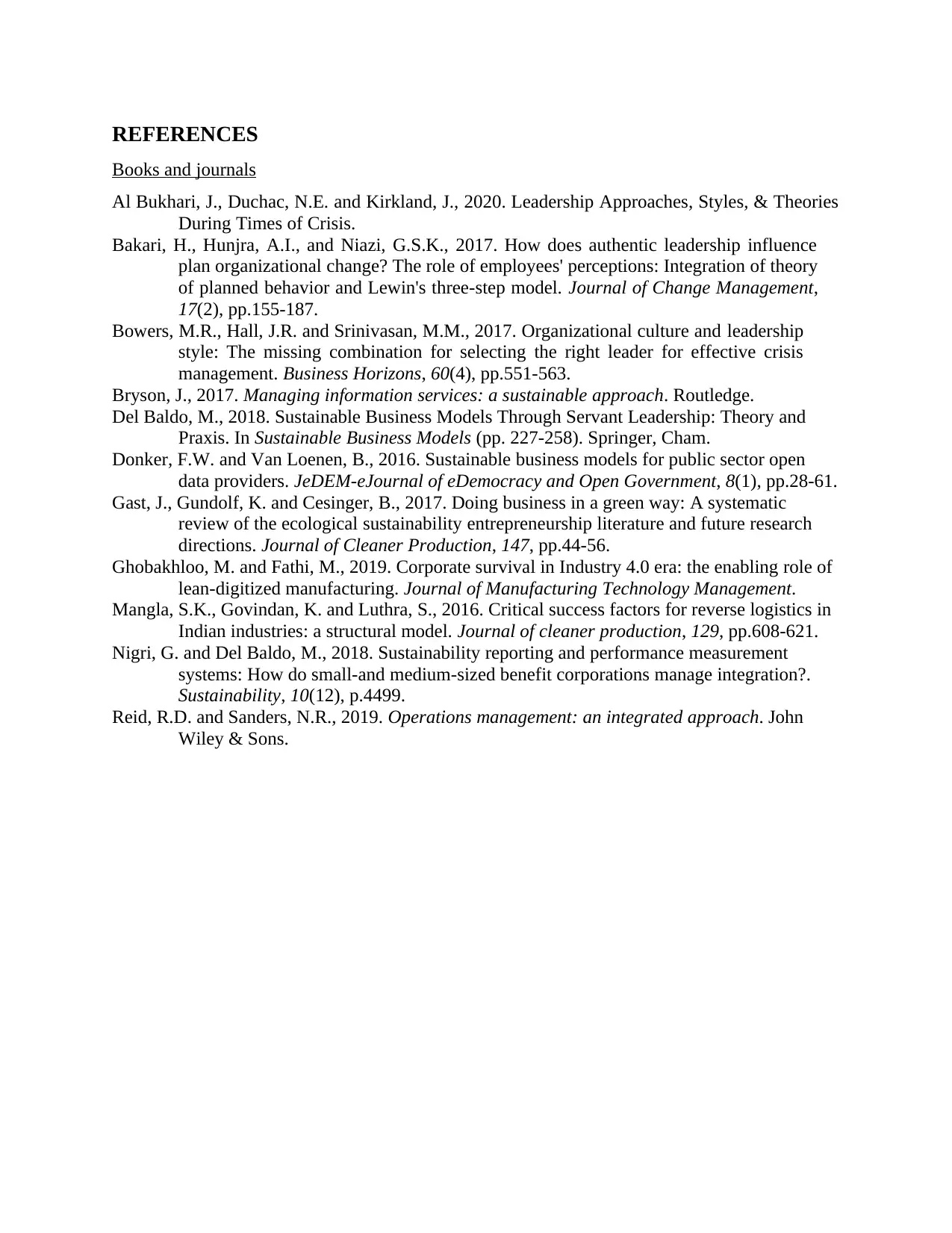
REFERENCES
Books and journals
Al Bukhari, J., Duchac, N.E. and Kirkland, J., 2020. Leadership Approaches, Styles, & Theories
During Times of Crisis.
Bakari, H., Hunjra, A.I., and Niazi, G.S.K., 2017. How does authentic leadership influence
plan organizational change? The role of employees' perceptions: Integration of theory
of planned behavior and Lewin's three-step model. Journal of Change Management,
17(2), pp.155-187.
Bowers, M.R., Hall, J.R. and Srinivasan, M.M., 2017. Organizational culture and leadership
style: The missing combination for selecting the right leader for effective crisis
management. Business Horizons, 60(4), pp.551-563.
Bryson, J., 2017. Managing information services: a sustainable approach. Routledge.
Del Baldo, M., 2018. Sustainable Business Models Through Servant Leadership: Theory and
Praxis. In Sustainable Business Models (pp. 227-258). Springer, Cham.
Donker, F.W. and Van Loenen, B., 2016. Sustainable business models for public sector open
data providers. JeDEM-eJournal of eDemocracy and Open Government, 8(1), pp.28-61.
Gast, J., Gundolf, K. and Cesinger, B., 2017. Doing business in a green way: A systematic
review of the ecological sustainability entrepreneurship literature and future research
directions. Journal of Cleaner Production, 147, pp.44-56.
Ghobakhloo, M. and Fathi, M., 2019. Corporate survival in Industry 4.0 era: the enabling role of
lean-digitized manufacturing. Journal of Manufacturing Technology Management.
Mangla, S.K., Govindan, K. and Luthra, S., 2016. Critical success factors for reverse logistics in
Indian industries: a structural model. Journal of cleaner production, 129, pp.608-621.
Nigri, G. and Del Baldo, M., 2018. Sustainability reporting and performance measurement
systems: How do small-and medium-sized benefit corporations manage integration?.
Sustainability, 10(12), p.4499.
Reid, R.D. and Sanders, N.R., 2019. Operations management: an integrated approach. John
Wiley & Sons.
Books and journals
Al Bukhari, J., Duchac, N.E. and Kirkland, J., 2020. Leadership Approaches, Styles, & Theories
During Times of Crisis.
Bakari, H., Hunjra, A.I., and Niazi, G.S.K., 2017. How does authentic leadership influence
plan organizational change? The role of employees' perceptions: Integration of theory
of planned behavior and Lewin's three-step model. Journal of Change Management,
17(2), pp.155-187.
Bowers, M.R., Hall, J.R. and Srinivasan, M.M., 2017. Organizational culture and leadership
style: The missing combination for selecting the right leader for effective crisis
management. Business Horizons, 60(4), pp.551-563.
Bryson, J., 2017. Managing information services: a sustainable approach. Routledge.
Del Baldo, M., 2018. Sustainable Business Models Through Servant Leadership: Theory and
Praxis. In Sustainable Business Models (pp. 227-258). Springer, Cham.
Donker, F.W. and Van Loenen, B., 2016. Sustainable business models for public sector open
data providers. JeDEM-eJournal of eDemocracy and Open Government, 8(1), pp.28-61.
Gast, J., Gundolf, K. and Cesinger, B., 2017. Doing business in a green way: A systematic
review of the ecological sustainability entrepreneurship literature and future research
directions. Journal of Cleaner Production, 147, pp.44-56.
Ghobakhloo, M. and Fathi, M., 2019. Corporate survival in Industry 4.0 era: the enabling role of
lean-digitized manufacturing. Journal of Manufacturing Technology Management.
Mangla, S.K., Govindan, K. and Luthra, S., 2016. Critical success factors for reverse logistics in
Indian industries: a structural model. Journal of cleaner production, 129, pp.608-621.
Nigri, G. and Del Baldo, M., 2018. Sustainability reporting and performance measurement
systems: How do small-and medium-sized benefit corporations manage integration?.
Sustainability, 10(12), p.4499.
Reid, R.D. and Sanders, N.R., 2019. Operations management: an integrated approach. John
Wiley & Sons.
1 out of 11
Related Documents
Your All-in-One AI-Powered Toolkit for Academic Success.
+13062052269
info@desklib.com
Available 24*7 on WhatsApp / Email
![[object Object]](/_next/static/media/star-bottom.7253800d.svg)
Unlock your academic potential
Copyright © 2020–2025 A2Z Services. All Rights Reserved. Developed and managed by ZUCOL.





